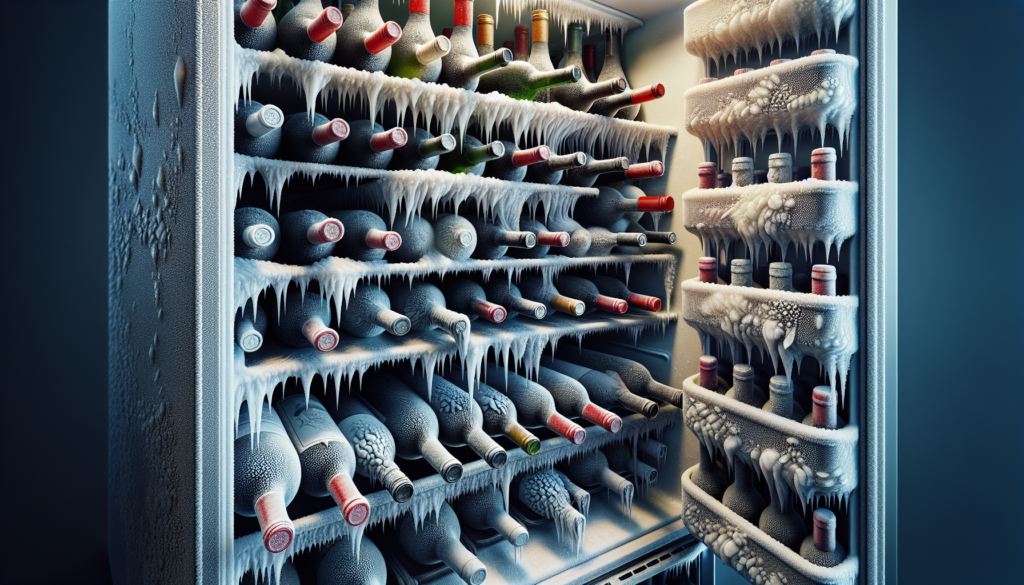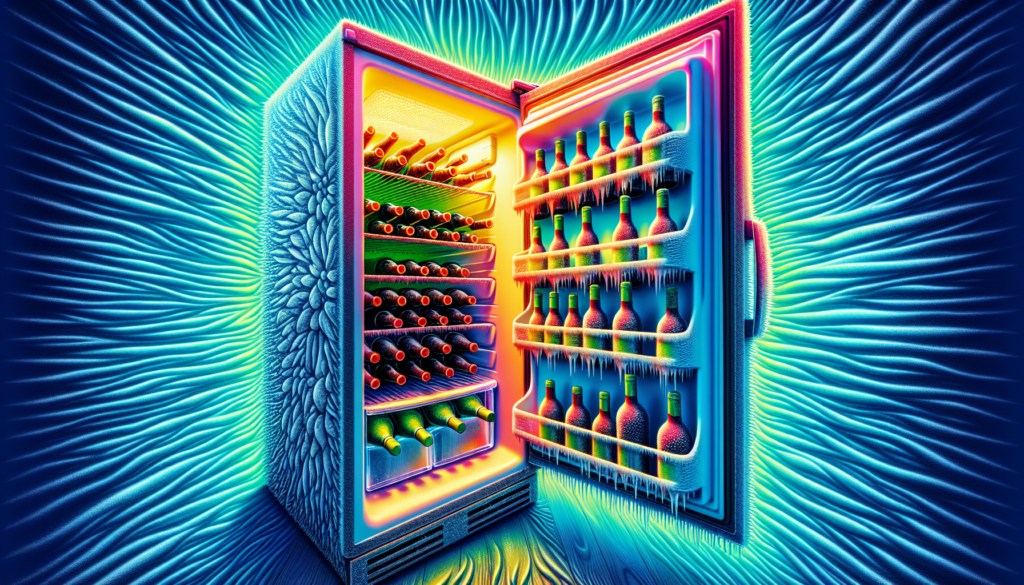Is your wine fridge not functioning as efficiently as it used to? Are you noticing a troublesome build-up of ice inside? If so, don’t worry, you’re not alone. Many wine enthusiasts face this issue, but fear not, because we have the solution for you. In this article, we will explore the reasons behind this ice build-up and provide simple yet effective ways to prevent and eliminate it. So grab your favorite glass of wine and get ready to say goodbye to that pesky ice.

Common Causes for Ice Build Up
Temperature Settings
One common cause of ice build up in a wine fridge is incorrect temperature settings. If the temperature inside the fridge is set too low, it can cause excess moisture in the air to freeze and result in ice accumulation. It is essential to ensure that the temperature settings are appropriate for storing wine and not set too low.
Poor Ventilation
Another factor that can contribute to ice build up is poor ventilation. If the airflow inside the wine fridge is restricted, the air may become stagnant and condensation can occur, leading to ice formation. It is crucial to make sure that the vents are clean and not blocked by any items placed inside the fridge.
Damaged Door Seal
A damaged door seal can also be a culprit behind ice build up in a wine fridge. When the door seal is compromised or worn out, cold air can escape and warm air can enter the fridge. This can lead to condensation and eventually ice formation. Checking the door seal regularly and replacing it if necessary is vital to prevent ice build up.
Faulty Defrost System
A faulty defrost system can be another common cause of ice build up in a wine fridge. If the defrost system fails to turn on or function properly, the freezer may not defrost as it should, resulting in ice accumulation. It is essential to ensure that the defrost system is in good working condition and schedule regular maintenance if needed.
Effects of Ice Build Up
Reduced Cooling Efficiency
Ice build up in a wine fridge can significantly reduce its cooling efficiency. The ice acts as an insulator, preventing the cooling elements from properly cooling the wine. This can lead to temperature fluctuations within the fridge, potentially compromising the quality of the wine being stored.
Increased Energy Consumption
When ice accumulates in a wine fridge, it forces the cooling system to work harder to maintain the desired temperature. This increased workload leads to higher energy consumption. If left unaddressed, it can result in inflated energy bills and unnecessary waste of electricity.
Potential Damage to Wine Bottles
Ice build up can also pose a risk to the wine bottles stored in the fridge. As the ice expands, it can exert pressure on the bottles, potentially causing damage to their labels, corks, or even the integrity of the bottles themselves. This can affect the appearance and quality of the wine, making it essential to address ice build up promptly.
Risk of Malfunction
If ice build up continues to persist, it can eventually lead to the malfunction of the wine fridge. The excessive ice formation can overload the cooling system, causing it to break down or work ineffectively. In some cases, this can result in irreversible damage to the appliance, necessitating costly repairs or replacement.
How to Remove Ice Build Up
Turn off the Fridge
To begin removing ice build up from a wine fridge, the first step is to turn off the appliance. This will prevent further ice formation and allow the existing ice to start melting.
Remove Contents and Shelves
Next, remove all the contents and shelves from the wine fridge. This will provide easy access to the interior and make the defrosting process more efficient.
Manually Defrost the Freezer
Using a towel or other absorbent material, start manually defrosting the freezer compartment of the wine fridge. Gently wipe away the ice and allow it to melt. It is essential to be patient during this process, as using sharp tools or excessive force can damage the interior of the fridge.
Clean the Interior
Once the ice has melted, use a mild cleaning solution and a soft cloth to clean the interior of the wine fridge. Remove any remaining moisture and ensure that the surfaces are dry before proceeding.
Check for Damaged Components
While cleaning the interior, carefully inspect the components of the wine fridge for any signs of damage or wear. Pay particular attention to the door seal, vents, and the defrost system. If any component is damaged, consider replacing it to prevent future ice build up.
Restart the Fridge
After completing the above steps, it is time to restart the wine fridge. Adjust the temperature settings to the recommended level for wine storage and allow the appliance to cool down before returning the contents and shelves back inside.
Preventing Ice Build Up
Maintain Proper Temperature Settings
To minimize the risk of ice build up in a wine fridge, it is essential to maintain proper temperature settings. Follow the manufacturer’s guidelines and set the temperature range appropriate for wine storage. Avoid setting the temperature too low, as it can lead to excess moisture and ice accumulation.
Ensure Proper Ventilation
Proper ventilation is crucial to prevent ice build up in a wine fridge. Ensure that the vents are not obstructed by any objects and regularly clean them to allow for adequate airflow. This will help reduce the chances of condensation and ice formation inside the fridge.
Regularly Inspect Door Seal
Regularly inspecting the door seal of the wine fridge is vital in preventing ice build up. Check for any signs of damage or wear, such as cracks or gaps. If any issues are detected, replace the door seal promptly to maintain an airtight seal and prevent cold air from escaping.
Schedule Routine Maintenance
To keep the wine fridge in optimal condition and prevent ice build up, it is advisable to schedule regular maintenance. This can include professional inspections, cleaning of components, and checking the defrost system. Regular maintenance helps identify and address any potential issues before they escalate.
Avoid Overstocking the Fridge
Overstocking the wine fridge can contribute to ice build up. When the fridge is filled to capacity, proper airflow can be restricted, leading to condensation and ice formation. To prevent this, avoid overstocking the fridge and ensure there is enough space between the bottles for adequate ventilation.

When to Seek Professional Help
Persistent Ice Build Up
If despite following the preventive measures, ice build up continues to persist in the wine fridge, it may be necessary to seek professional help. A technician specializing in refrigeration systems can diagnose and fix any underlying issues that may be causing the problem.
Recurring Issues
If ice build up becomes a recurring problem, it is advisable to consult a professional. They can identify any underlying issues with the wine fridge that may need to be addressed to prevent future ice accumulation.
Unusual Noises or Smells
Unusual noises or smells coming from the wine fridge can indicate a malfunction. If ice build up is accompanied by these symptoms, professional assistance should be sought to diagnose and rectify the problem.
Inadequate Cooling Performance
If the wine fridge is not cooling the contents effectively or is unable to maintain the desired temperature, it could be a sign of a larger issue. Seeking professional help in such cases can ensure proper diagnosis and resolution of the problem, preventing further damage to the appliance and the stored wine.
In conclusion, ice build up in a wine fridge can be caused by temperature settings, poor ventilation, damaged door seals, or faulty defrost systems. It can lead to reduced cooling efficiency, increased energy consumption, potential damage to wine bottles, and the risk of appliance malfunction. To remove ice build up, the fridge should be turned off, contents and shelves removed, and the freezer manually defrosted. Regular maintenance, proper temperature and ventilation, and inspecting the door seal can help prevent ice build up. It is important to seek professional help if ice build up persists, issues recur, unusual noises or smells occur, or there is inadequate cooling performance. By following these steps and seeking assistance when needed, you can ensure a well-functioning wine fridge and properly stored wine.
